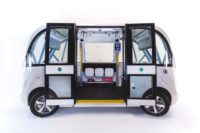BUSAN, South Korea—Engineers at the Korea Maritime & Ocean University here have developed a new systems for guiding autonomous ships. Their computational fluid dynamics model can lead to more accurate predictions and safer navigation of maritime autonomous surface surface ships (MASS).
An essential requirement of MASS is the ability to follow a predetermined path at sea, considering factors such as obstacles, water depth and ship maneuverability. Any deviation from this path, due to adverse weather conditions or other factors, poses serious risks like collision, contact or grounding incidents.
Current methods for assessing the path-following performance of autonomous ships rely on simplified mathematical ship models. Unfortunately, these models are unable to capture the complicated interactions between the hull, propeller, rudder and external loads of ships, leading to inaccurate estimates of path-following performance.
A team of engineers led by Daejeong Kim, Ph.D., an assistant professor of navigation convergence studies, studied the path-following performance of MASS using a free-running computational fluid dynamics (CFD) model combined with the line-of-sight (LOS) guidance system, at low speeds under adverse weather conditions.
“We employed a CFD model based on a fully nonlinear unsteady Reynolds-Averaged Navier-Stokes solver that can incorporate viscous and turbulent effects and the free surface resolution critical to path-following problems, enabling a better prediction of path-following performance,” explains Kim.
The engineers employed the CFD-based analysis on the popular KRISO container ship model equipped with the autonomous LOS guidance system. The adverse weather conditions were modeled as disturbances from the bow, beam and quartering sea waves, and these three cases were studied at three different speeds to identify the effect of forward speeds on the path-following performance. Simulations revealed that the ship experienced oscillatory deviations in all the three cases.
“The proposed CFD-based model can provide a valuable contribution to enhancing the safety of autonomous marine navigation,” says Kim. “Moreover, it can also offer low-cost alternatives to model-scale free-running experiments or full-scale sea trials.”




